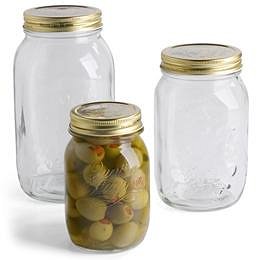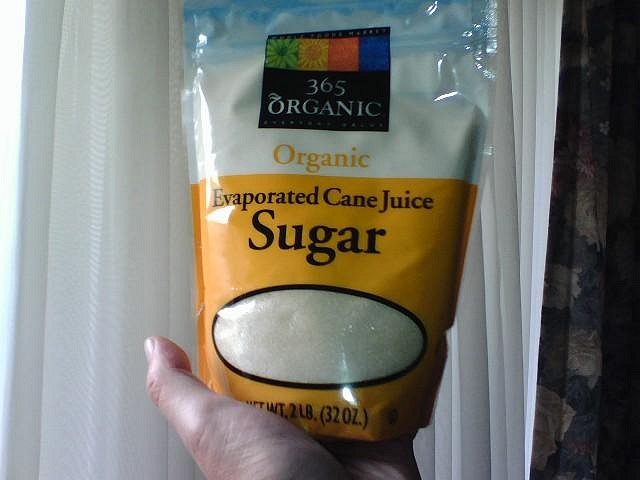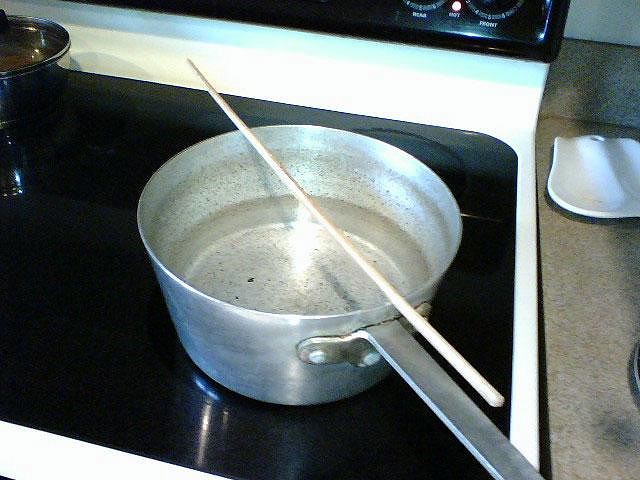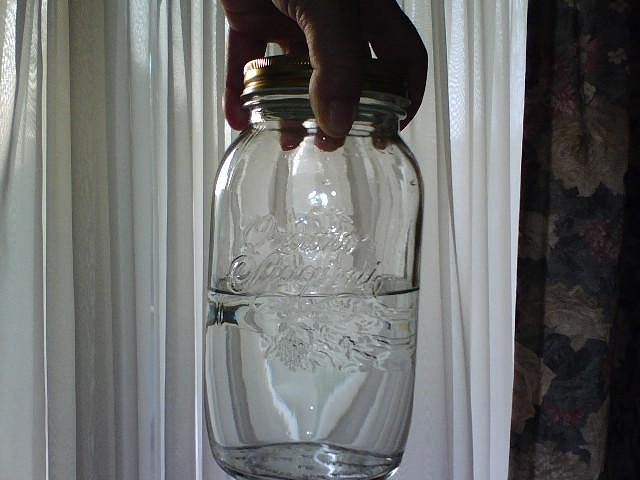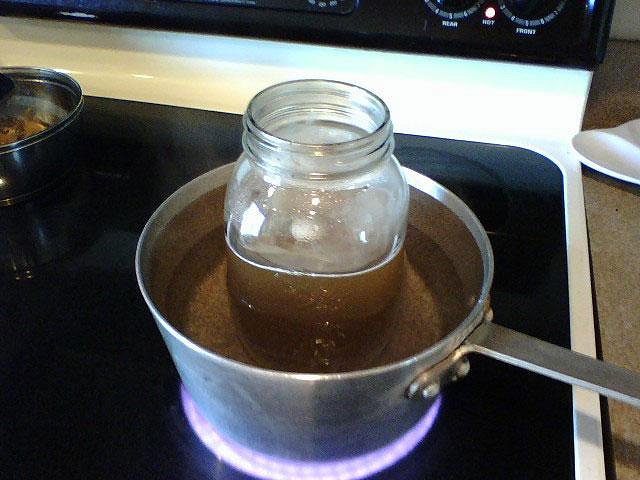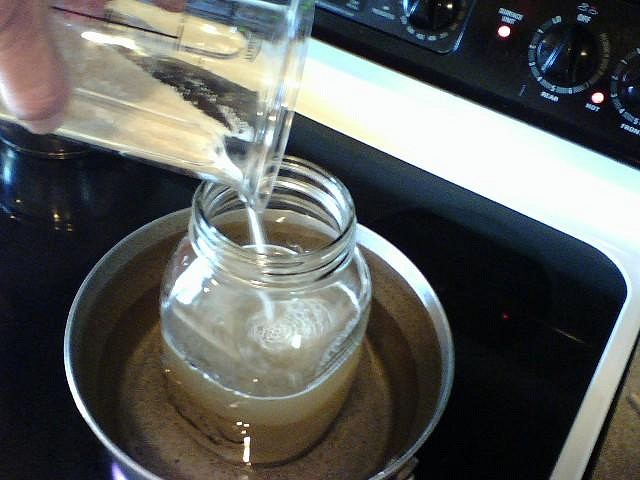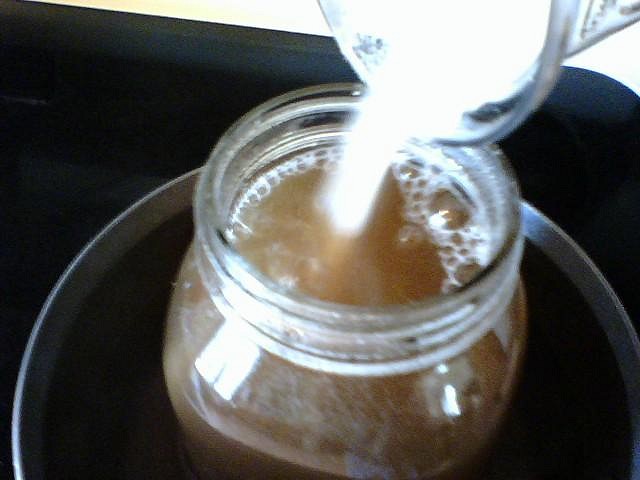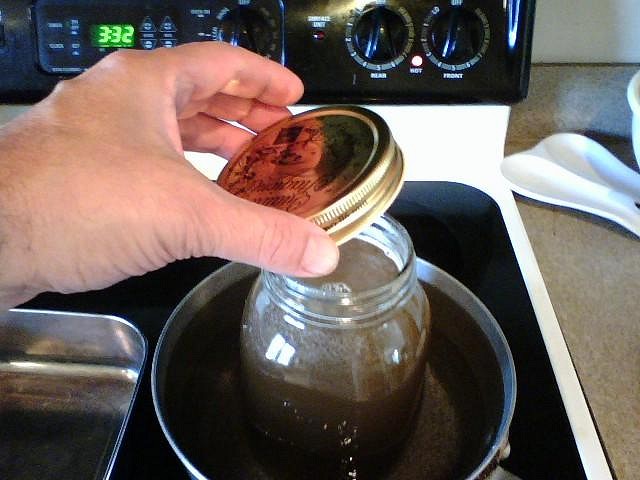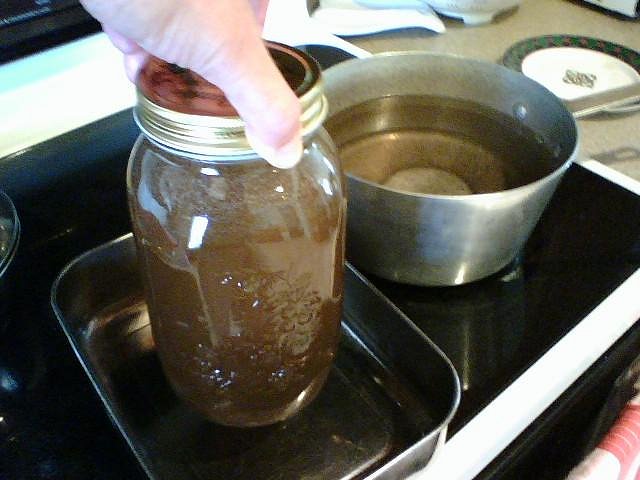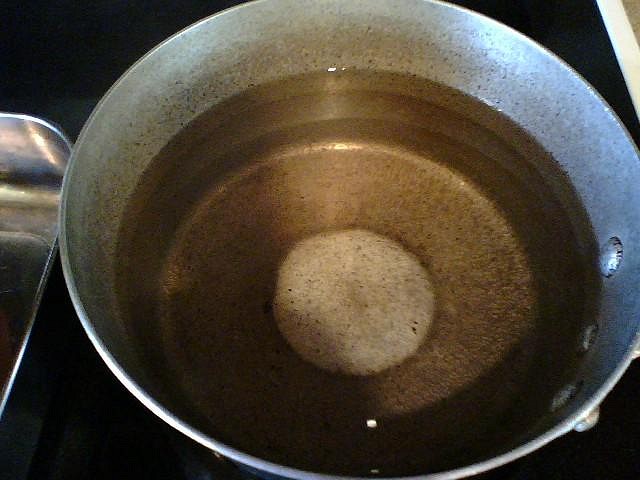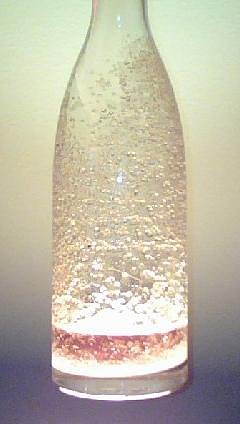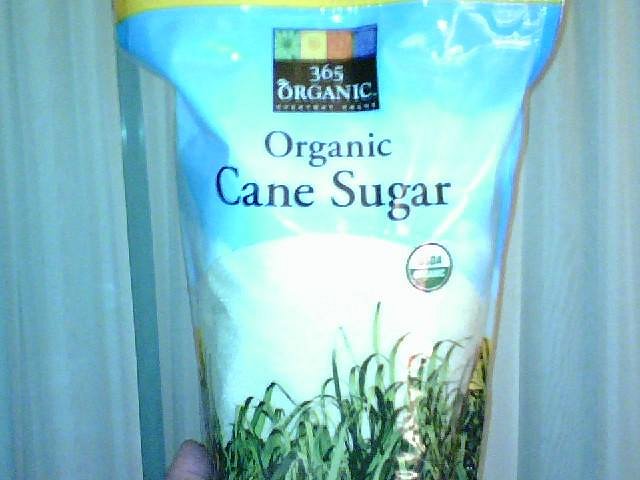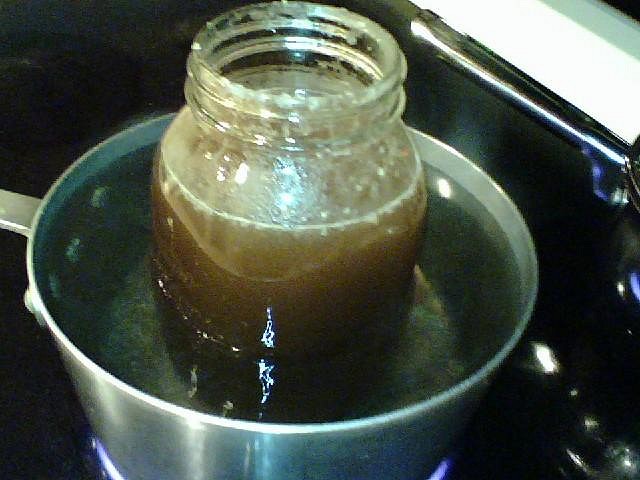Tiki Central / Tiki Drinks and Food
How To Make Rock Candy Syrup
Pages: 1 35 replies
|
TG
The Gnomon
Posted
posted
on
Mon, Sep 17, 2007 7:54 AM
This thread started in one devoted to Orgeat, so I have copied it here and have added some text and pics (using my cell phone—sorry for the lack of quality).
Yes indeedy. It just about the easiest thing in the world to make and it's kinda fun. It's fun because it's easy and because you're jamming more sugar into a single space than "belongs" in that space, so it becomes unstable. Next time I do up a batch I'll try to take some pictures to dump back in here. Especially considering the length of this post, it probably should be relocated to a rock candy syrup thread. But since you asked me here... First, I guess I should start by distinguishing rock candy syrup from simple syrup. Simple Syrup vs Rock Candy Syrup Simple syrup is similar to rock candy syrup, being made from exactly the same thing as each other, sugar and water. Simple syrup is water saturated with sugar. Rock candy syrup is water supersaturated with sugar. The solution is saturated when under normal atmospheric conditions (i.e., room temperature) you can't dissolve any more sugar into the water. If you put another granule of sugar in and stir it around for a long time it doesn't dissolve. There is no room left in the water for any more sugar. It's saturated. Supersaturation is putting more sugar into the water anyway. When you force more sugar into water that is already saturated, it becomes supersaturated. The more supersaturated it becomes the more unstable it becomes. Instability here means that the "extra" sugar that has been forced into the solution "wants" to get out of the solution and it gets what it wants. How quickly and to what degree depends on how unstable it is. The stuff that falls out is called precipitate, just as rain is the precipitate when the atmosphere is supersaturated with water molecules. When highly unstable sugar water "rains" the precipitate is rock candy, hence, rock candy syrup. When you start the process you will be making simple syrup, but before long you'll cross the line into supersaturation and will be making rock candy syrup. A volume of kick-ass rock candy syrup is noticeably heavier than the same volume of simple syrup because sugar is heavy and there is a ton more sugar in the rock candy syrup. Least Messy Method of Making Rock Candy Syrup I keep my main batches of RC syrup in big Quattro Stagioni canning jars like the one on the far left. I decant from the big jars into a small bottle for mixological purposes.
The reason for storing it in jars like this is they are canning jars, which means they are designed to take the heat of pasturization (like when making preserves, etc.) So...you can make the syrup right in these jars. That makes this the least messy method I know. I used to make the syrup in a big pot, allow it to cool overnight, transfer the syrup into these big jars (pouring through a big funnel), and then wash the pot and funnel. This can turn into a big mess. Because my batches tend to be ultra unstable, often enough I'll have to dilute my syrup to avoid a blizzard of rock candy from occurring. It's nice to look at, and it's what you want IF your intention is to make rock candy, but within a matter of a few days you can end up with a brick of rock candy the exact shape as the inside of the jar. Anyway, to dilute my batch, I'd remove some of the syrup, replace that with more water and, knowing it was a canning jar, I'd just leave it in the jar and heat the the whole thing up in a pot of boiling water as I stirred the solution in the jar. That's when I realized the thing should be done from the very beginng right in the jar the whole time. Rock Candy If you make a solution that is unstable enough to precipitate like crazy, you can make rock candy by suspending a string (or just about anything really) down into the syrup and let it sit there for a few days. The more unstable the solution the faster the rock candy will form. I'm living in temporary digs right now, so most of my stuff is in storage. Consequently, I don't make any of my fancy garnishes. One of the techniques I use in some of my garnishes is to make rock candy on the submersible end of my bamboo swizzle sticks. But 99% maybe of the RC syrup I make is for mixing into drinks. Water Use the best water available, which usually means the purest, but it could mean a spring water you like that, technically, might not be as pure as some other water you could get. You just don't want unfiltered tap water or any water that has other stuff dissolved in it. You want this to be as close to pure sugar water as you can get. Sugar Any sugar can be used to make rock candy syrup, but I prefer to use very high quality sugar that is minimally processed, so my syrup is really dark. You can still use it in light colored drinks without making the drink dark. For the batch in these pics, I decided to give Whole Foods 365 Organic Evaporated Cane Juice Sugar a try. It's cheaper than the Florida Crystals I've used for the previous several batches.
Other Equipment You'll need a big pot and a stirring stick. I use a Chinese bamboo cooking tong (giant chopstick). This is better than a spoon of any kind, but a wooden spoon is OK if that's all you've got. Have a cup, glass, or other vessle standing by.
Essential Prep Inasmuch as you'll be hanging out in the kitchen stirring your syrup more or less continuously for an hour, it is advisable that you make yourself a 15 oz Mai Tai (or other concoction) while you wait for the big pot of water to come to a boil. The Setup
Fill your canning jar about halfway with spring/filtered water. Stir in sugar until the level of the mixture reaches about three quarters full. Don't worry about dissolving the sugar yet, you just want to add some weight to the water before putting it into the big pot. Fill the big pot about three quarters full of hot tap water and put it on the big front burner of your stove. Then set the canning jar with the beginnings of your syrup down into the center of the big pot of tap water. Use the cup, glass, or other vessel you have standing by to add hot tap water to the big pot until the water level is about a half inch from the top. Your jar with the sugar and water mixture should be sticking up (probably 3 – 5 inches) out of the hot tap water. Turn the burner on High and go make your drink while this comes to a boil.
NOTE: For this batch, since my big pot wasn't that big, I didn't need to add any sugar for weight ahead of time. If the water level outside the jar is significantly higher than the level inside, you'll have to add the sugar for weight first. While the water is heating up I stir in about a pound of sugar to get things started. It will dissolve long before your water comes to a boil. Essence of the Procedure The way to force enough sugar into water to supersaturate it is to add the sugar under heat. To dissolve it as fast as possible and to avoid burning any of the sugar it is necessary to keep the solution moving, which means stirring pretty much continuously until it's done. By stirring it in the jar sitting in boiling water, it is heated from not only the bottom, but from the sides as well, which makes it easier to force more sugar into the solution. You just keep stirring in more and more sugar (about a cup at a time) until the solution reaches the top of the jar. There is a limit to the amount of additional sugar you can force into the solution. When that limit is reached, any sugar you put in will fail to dissolve and just fall to the bottom of the jar no matter how much you stir it. The only way to dissolve that sugar in that same amount of water is to add more heat, which you would not be able to do on your stove top. If you do not put enough water in the jar to start with (e.g., only one quarter full instead of half) then you would probably reach a point where you could not dissolve more sugar before you brought the level up to the top of the jar.
NOTE: This batch uses a jar half full of water, which makes the syrup moderately stable, which probably suits most peoples' needs. I usually use one third full, which makes for a very unstable batch 'cause you can cram another pound or so of sugar into the solution. I needed syrup right away, so I decanted some from this batch, leaving room in the jar for more sugar. I will go back later and heat the syrup back up and stir in more sugar until it becomes quite unruly. Working the Burner Control The more sugar that is in the solution the higher it's boiling point. I guess at some point it just explodes :) but your stove won't be able to get it hot enough for you to find out. You want to keep the big pot as full of tap water as possible so that the jar is as immersed in boiling water as possible. If you boil the water fast it will be splashing all over your stove since the pot will be so full. Therefore, you want to put it on simmer once you have reached the initial boil, but you want to gradually increase the heat as you add more sugar. When you add sugar it draws the heat from the boiling water, so you need to turn it up slightly just to maintain a simmer. The more sugar that is in the solution, the more heat that must be applied to the boiling water to maintain a simmer. Eventually, the syrup solution will be really hot and supersaturated to a point where sugar does not dissolve so easily. When you add sugar to the swirling liquid it spirals around and looks a little like a rope. You'll see. When you get to that stage, your syrup is more or less ready. If you keep adding more anyway (because you can), you might end up with something that is more unstable than you want. Unless you don't mind heating it all up again later to dilute it, resist the urge to go overboard. Finishing Touches Once you finished stirring in sugar, you have to let the whole thing cool. Take the jar lid and screw it onto the hot jar momentarily. Lift the jar out of the scalding water and set it on a wooden cutting board or a trivet to cool overnight. I use my bare hand to lift it out. The jar lid doesn't heat up fast enough for me to need a hot pad or anything. Now unscrew the lid so that it is very loose. Another virtue of doing all of this in the canning jar is that the jar lid serves as a tool to lift it out of the heat and as a loose cover to allow heat to escape while protecting it from any ants, fruitflies, or other sugar-loving vermin that might be hiding and also waiting for your syrup to cool.
Let it sit out over night and in the morning screw the cap on tight. Voilá! If you make an incredibly unstable batch, the next day you should see the syrup taking on a marbling effect of rapidly forming rock candy crystals. That will tell you that you've overdone it and can expect to have to fix it soon. If it is moderately unstable, there will be time for gravity to kick in as the crystals form, so over the course of 1 – 3 days you'll just see a sedimentary layer of rock candy crystals forming at the bottom of the jar. That's what you want if you're using the syrup for drinks. Later, when your jar is empty, just make a new batch leaving the rock candy at the bottom. It will dissolve in the process of making the next batch. When you heat the jar in a pot, unless your tap water is exceptionally pure, the minerals in the water will stick to the pot.
The underside of the jar is slightly concave, so in the boiling process water is forced out and that space is occupied by mainly very hot water vapor, which doesn't deposit minerals like it does in the water. You can see the effect in the pic. It takes a little elbow grease and an SOS pad to remove the minerals, so make sure you use a pot that can stand such abuse. [ Edited by: The Gnomon 2007-09-17 08:05 ] |
|
TG
The Gnomon
Posted
posted
on
Mon, Sep 17, 2007 7:57 AM
Again, in response to Scottes interest,... Well, if you want to try it, here's a fancy swizzle stick I invented a few years back. I call it the Pickless Drink Pick Rock Candy Swizzle Stick: You can get spare lids for these canning jars. Poke/drill holes in a spare lid spaced about ½" apart. Mine are aligned in the form of a hexagon, so there are 19 holes. You want to make the holes just a little larger than the diameter of the bamboo sticks. I use bamboo skewers, which are readily available in all the grocery stores. They are pointed on one end and flat on the other. The trick to this particular swizzle stick is that you submerse the flat end and leave the pointed end sticking up in the air. You'll need a small piece of corrugted board (ideally—'cause it holds better), but you could also use a piece of chip board (aka, cardboard). You put that on top of the lid, taping it to the lid around the edges, to hold the sticks in place and keep them from sliding out of the lid or otherwise moving around. Push the sticks into the holes in the lid from the inside/underside—through the lid and into the corrugated board. You position the sticks in the lid so that they are all vertical and do not touch each other. The sticks should be protruding enough beneath the lid for about two inches of the stick to be submersed in the rock candy syrup when you put the lid on the jar. This can be a little tricky as the sticks can move around a little as you screw the lid on the jar. You want to make sure you don't wobble them around so much that the corrugated board loses its grip on any sticks. The idea is for the sticks to remain as still as possible submersed in the rock candy syrup until enough rock candy has formed on them to suit you. When the diameter of the rock candy around the stick reaches about ¼" it's a good time to take them out. There are two things you can do to speed up the formation. First is to make sure that the rock candy syrup is as unstable as you can possibly make it. Under those conditions, the sugar in the syrup will be aching to jump out of the solution and anything that sits around in the syrup is its first target. Second is to dip the sticks into the syrup for a brief moment then let them dry. When they're dry, put them back into the syrup and let it sit until they're done. By doing this, the initial dip evaporates and causes a very thin layer of rock candy to form on the sticks right away. Rock candy forms faster on existing rock candy. It's a crystal and that's what crystals do. By forcing this layer to form quickly, you don't have to wait for sugar molecules to drift around in the solution and "hunt" for a place to form. You're telling them where the party is right off the bat. When you are ready to dry the sticks, whether in making the initial base layer or at the end when they're done, just screw the cap with the sticks onto an empty jar. Once they're dry, you'll have a bunch of bamboo sticks with a point on one end and a rock candy crystal on the other. The beauty of this is that you can now skewer pinapple chunks and other fruit down over the point to where it meets the rock candy crystal. Then you snip off the point with something. I use a pair of needle nose pliers that has a wirecutter. Do something decorative to the snipped off end and you have yourself an amazing pickless drink pick rock candy swizzle stick. I used to use sealing wax (the kind used to put a seal on letters) as one treatment to the tip. A glob of sealing wax hardens and cools fast, plus it obscures the fact that the fruit was skewered from that end, so it's a momentary visual puzzle. The mind wants to think that the fruit was skewered from the end sitting down in the drink, but that's not possible onnacounta there's a rock candy crystal in the way. :) If you decide to use sealing wax, mash the snipped tip with pliers so that it fans out a little and the sealing wax doesn't accidentally come off. You can eat the fruit off the stick or wait until the rock candy dissolves enough to slide the fruit off the stick. |
|
KC
Kona Chris
Posted
posted
on
Mon, Sep 17, 2007 3:20 PM
Would it be possible to get the rock candy to grow over the fruit garnish? THAT would be pretty spiffy! I think if you let it grow in the fridge, it might just work, and certainly would be cool looking, depending on how long you let it grow. Chris |
|
TG
The Gnomon
Posted
posted
on
Tue, Sep 18, 2007 8:23 AM
It would be cool looking, but I don't think you'd have any success as long as you use fresh fruit for your garnish. You might have some luck with dried fruit, especially, if the fruit already has some crystallization on its surface. But I don't find the idea of using dried fruit very attractive. Acidity and rock candy do not mix. Candy makers use acidic ingredients to soften their candy. The hard crystals are inhibited from forming in the presence of acid. Pineapple is acidic, for example, so as a fresh fruit I would expect it to get nowhere as far as acting as a seed base for sugar crystals is concerned. On the other hand, the sugar in pineapple can crystallize on its surface when it is dried sufficently to have evaporated enough of its acidic juice. Of course, when it's dry it's kinda hard, but you can still force a skewer through it if it's not too hard. Then the sugar crystals on the pineapple surface would probably be able to seed rock candy crystals if the syrup was very unstable. Would this make a decent garnish? I don't think so, which is why I've never tried it. There are lots of dried fruits around and I'd thought about how they'd fare as garnishes, but I always concluded that they'd generally be unappealing. You might find otherwise. Let me know if you try it. |
|
CAA
Chip and Andy
Posted
posted
on
Tue, Sep 18, 2007 5:20 PM
Nice step-by-step. I really like the candy picks too, nice touch. And, looking at the pictures I gotta say.. Dude! Are you on well water or City water? If you get that much mineral buildup out of your City Water you better start writing to your elected officials. That looks nasty! |
|
TG
The Gnomon
Posted
posted
on
Wed, Sep 19, 2007 5:18 AM
I guess it won't be a shock to tell you that I only drink bottled water where I am. Whenever I make RCS, I am reminded of why. :lol: :o :roll: But now that you mention it, I really should buy a few gallons of cheap bottled water to use instead of tap water for my next batch, then replace the current pics. The upside is I don't have to take nutritional supplements to get my minerals. I just have to take a quick shower. :D [ Edited by: The Gnomon 2007-09-19 06:22 ] |
|
O
Ojaitimo
Posted
posted
on
Mon, Oct 1, 2007 10:56 PM
Thanks for the rock candy lesson. It was instructional as Alton Brown's Good Eats. [ Edited by: Ojaitimo 2007-10-01 23:02 ] |
|
O
Ojaitimo
Posted
posted
on
Mon, Oct 1, 2007 10:57 PM
Now that you mention the tree frogs, I thought of Sabu, he makes these secret chicken sticks that everyone is crazy about? [ Edited by: Ojaitimo 2007-10-01 23:07 ] |
|
TG
The Gnomon
Posted
posted
on
Tue, Oct 2, 2007 5:19 AM
When I was in Beijing they made a lot of stuff with "secret chicken, secret beef, secret pork, secret fish ..." The miracle of mystery meat. |
|
G
GentleHangman
Posted
posted
on
Tue, Oct 2, 2007 5:57 AM
You won't be wanting my Pot-stickers recipe then. |
|
TG
The Gnomon
Posted
posted
on
Tue, Oct 2, 2007 6:08 AM
If it starts out, "First round up all the stray dogs and cats in your neighborhood..." I'm in. It'll bring back memories of China. If it starts out, "Cut out some green paper into the shape of a cannabis leaf and spray adhesive on the back..." I might be in. It would bring back memories of... well, just bring back my memory. |
|
TG
The Gnomon
Posted
posted
on
Mon, Dec 10, 2007 7:18 AM
When I make RCS, I keep it in the large canning jar where it's made and decant portions into a separate bottle for dispensing. When you have a fairly unstable solution (highly supersaturated with sugar), here's what happens to the inside of the dispensing bottle after it's been refilled a few times.
As you can see, there are about one or two more pours left before it needs to be refilled. There's about ¼" of rock candy formed on the bottom and RC crystals are forming like barnacles all over the inside. It is rather decorative. I'll keep refilling this one until it glazes over to the point that it loses the scintillation effects. In the canning jar, the RC mainly crytallizes on the bottom (unless you suspend something inside it). That's because the jar is air tight and there's no water loss to speak of. The barnicular formations are brought on by the drying of the inside wall of the bottle as RCS is removed. In the dispensing vehicle, with all the opening, closing , and pouring, there is a fair amount of water loss. When water evaporates from the syrup coating the sides it hastens the formation of RC crystals. So they create a candy jewel studding. Eventually, it gets so thick that it loses the effect and just glazes over. That's when it's time to dissolve the RC coating and start over. RCS is so much more powerful than simple syrup. This is just a visual reminder of that fact. No reason to settle for anything less than superior quality since it's so easy to make. English is just my native language [ Edited by: The Gnomon 2007-12-10 09:49 ] |
|
DH
DJ HawaiianShirt
Posted
posted
on
Tue, Dec 11, 2007 10:52 AM
I'm sorry, but are you saying that rock candy syrup is of "higher quality" than simple syrup? I sure hope not. The quality of any sugar syrup is limited to the quality of the sugar and water involved, regardless of concentration. Also, I'm not sure I see the big deal with RCS. Is anyone using it instead of simple syrup? Because they shouldn't be. RCS is so much sweeter than SS that any substitution of one for the other completely and utterly changes a cocktail, and rarely for the better. Balance is lost. Unless you're making a RCS that is, say, exactly twice (or thrice) as strong as normal SS (so that you can calculate how much less to use in a recipe), then I'm not sure it should be used at all. Also, as we've noted, the degree to which you can supersaturate your syrup is a function of many factors. So in the end, different RCSs will be of different intensities. This creates a variation between the end result of cocktail recipes that is less-than-ideal and is not consistent. I'm sorry if I'm commenting on things that you didn't say or mean. I'm just trying to say that I see RCS as nothing more than a simple(if inconsistent) ingredient to be called for in a recipe, or as a visual and scientific novelty, and I caution anyone trying to use it as a replacement(or "enhancement") for anything else. |
|
S
Scottes
Posted
posted
on
Tue, Dec 11, 2007 11:00 AM
I read this as "make your own RCS and make it a quality RCS" I definitely did not read this as a statement of RCS's superiority over SS. And isn't RCS one of TV's original ingredients in the Mai Tai? That makes it quite valid IMHO. I wouldn't consider it to be a replacement for SS without some testing. I most certainly would not substitute 1/4oz of RCS for 1/4oz of SS!! [ Edited by: Scottes 2007-12-11 11:03 ] |
|
DH
DJ HawaiianShirt
Posted
posted
on
Tue, Dec 11, 2007 12:09 PM
You might be right, Scottes. Who knows how I read it? Anyway, if the original Mai Tai called for RCS, then I would hope that proportions changed with the usage of SS. Does someone know about this? |
|
S
Scottes
Posted
posted
on
Tue, Dec 11, 2007 12:43 PM
THE ORIGINAL FORMULA 2 ounces 17-year-old J. Wray Nephew Jamaican rum Even though I know better, I always seem to make the first Mai Tai of the night with regular SS. I always pour more in afterwards. But all this has a tendency to change the mouthfeel as well as the sweetness... |
|
TG
The Gnomon
Posted
posted
on
Tue, Dec 11, 2007 1:23 PM
Homemade RCS is of superior quality to any you can buy. If you are into RCS, then there is no reason to buy someone else's. It's so easy to always have the best. As for me, I don't really have any use for simple syrup. I'd use it to make a cocktail if that's all that there was available, but it would not be my choice. The main virtue I was extolling was the fact that controlling the ingredients yourself produces the best results and its too easy to do to not do it. But I disagree with you on the SS vs RCS. The magic of RCS is that it is supersaturated. It has a lot more potential than SS. You can do everything with RCS that you can do with SS, but not vice versa. To me, that makes it significantly better for me, not necessarily for you or others. I mainly use it for other things besides cocktails, where often the supersaturated properties of the RCS are essential, so SS is useless in those cases. I can see how inconsistency in different batches of RCS might present a challenge to those who just use it for making cocktails. This is, no doubt, why Scottes seeks to establish a standardized formula for, let's call it, bar-quality RCS (same thing for Orgeat). In so doing, people could make superior RCS (and Orgeat) that they could rely on for mixological consistency. |
|
M

Melintur
Posted
posted
on
Thu, Dec 13, 2007 9:15 AM
Your lime juice's sourness will always be an unknown: It will be different with every lime juiced. That's why you'll need to sample the beverage with a bar straw (finger covering hole; pipette method) to make sure you've balanced with your sweetener. You do sample for balance every drink you serve, don't you? :wink: |
|
S
Swanky
Posted
posted
on
Thu, Dec 13, 2007 10:11 AM
Add a few drops of lemon juice to the mixture to prevent the precipitation. The acid is a catalyst. You'll never taste it, but it will help emmensely. |
|
K
kleptic
Posted
posted
on
Fri, Feb 8, 2008 7:18 PM
if using the pot method instead of the jar method, how much water should you start with and how much sugar should you add to the water? I read that simple syrup is 1 cup water, 1 pound sugar, i think a pound of sugar is roughly 2 cups. I guess that could be wrong altogether but I'm wondering what the general measurements are for sugar to water in rock candy syrup. thanks [ Edited by: kleptic 2008-02-08 19:19 ] |
|
TG
The Gnomon
Posted
posted
on
Mon, Feb 11, 2008 4:43 AM
When I want industrial strength instability in my rock candy syrup I use the pot method. The jar method prevents you from applying too much heat to the syrup because it relies mainly on the heat of the water, which can boil faster, but not get hotter. Take the syrup out of the jar and heat it directly in the pot and you can deliver much higher temperatures. That means you can force a lot more sugar into any given amount of water. That, in turn, means exceptionally dense RCS. Using that method you're limited by the heating capability of your stove and your resources. I occasionally run out of sugar using the pot method. You just keep stirring more in, edging the heat up, and eventually, you run out of sugar. If, however, you have a ton of sugar on hand, you'll reach a point where your stove is as hot as it can get and stirring as fast and long as you can you can't get any more sugar to dissolve. That's the upper limit for that particular set up. That's also way beyond what you'll ever need. That kind of syrup is so unstable, as it cools rock candy starts to form kind of like marble throughout the syrup. If you let it keep going, it will completely crystallize in a few days taking on the shape of its container. If you make a batch lof RCS like that, it should be strictly to make rock candy 'cause you'll get plenty of it whether you want it or not. The pot method gives you this capability. It can be a blessing or a curse. Using the jar method puts reins on going overboard. In any event, I would start with 1/4 to 1/3 the volume of the container where you'll be keeping it for the water component and just keep adding sugar until the volume expands enough to fill the container. Fill your container with water and pour it all into the pot, making note of the water level in the pot. You can take a chopstick and mark that level using it like a dip stick or just eyeball it. Empty that water from the pot and pour in an amount equal to 1/4 to 1/3 the volume of the container you'll be filling. As that water boils, keep adding sugar until the surface of the syrup reaches the target depth of your dip stick. You should probably try it with 1/3 first. If you like it stronger, go to 1/4 after that. |
|
S

swizzle
Posted
posted
on
Tue, Feb 12, 2008 4:12 PM
There is an excellent chapter in the book 'Mixologist: The Journal of the American Cocktail' (i'm not sure if it's volume 1 or 2) called: 'The definitive guide to simple syrup', by a guy called Darcy S.O'Neil. [ Edited by: swizzle 2015-10-09 04:14 ] |
|
G
GatorRob
Posted
posted
on
Wed, Feb 13, 2008 8:52 AM
It's in book 2. I think. I don't have them near me right now. If you like Darcy's Alton Brown-like approach to writing about cocktails (and I do), check out his blog, Art of Drink. |
|
K
kleptic
Posted
posted
on
Wed, Feb 13, 2008 6:34 PM
thanks, I broke down and ordered some 1.6 liter mason jars. they should be here tomorrow and I'm going to make some rock candy syrup and some orgeat. After tasting my home made passion fruit syrup and then tasting my trader vics rock candy and orgeat all I could taste was corn syrup. my wife kind of thinks I'm crazy making all these syrups myself now but man the difference seems so huge and its not that much work. seems strange that we don't have a "rock candy standard" somebody should come up with a cup to pound ratio for perfect rock candy syrup for drinks. I'll give the 1/3 a jar of water thing a shot tomorrow though. wish me luck. |
|
TG
The Gnomon
Posted
posted
on
Thu, Feb 14, 2008 8:21 AM
The RCS is the easiest thing in the world to make. The orgeat OTOH is pretty involved. If you do it right, making your own almond milk rather than store bought, use nylon straining bags rather than cheese cloth if you can. Scottes located them a while back and when I got mine I could see why he was raving about them. As for the "rock candy standard", you're preaching to Scottes' choir. When I do the jar method, after stirring in the maximum amount of sugar that the heat of boiling water will allow, the syrup is moderately unstable, and is a kind of standard in itself. It's regulated by the fact that it can only be heated to essentially the temperature of boiling water (it's actually slightly higher because a small amount of additional heat is transferred into the syrup from the burner, to the pot, to the glass). |
|
S
Scottes
Posted
posted
on
Thu, Feb 14, 2008 8:46 AM
Search for something like "nylon straining bags" at any wine-making store, since they're often used for straining the grape solids when making wine. Imagine a bag made out of fairly fine cheese-cloth that's made out of nylon. Super strong, and re-usable many times. Just throw them in the washing machine after using. (Permanent Press Cycle, Warm Rinse, no bleach.)(just kidding)
Yep. One of these days I'll make RCS and will most certainly measure the amount of water and sugar and post those measurements. Down to the gram. :) And then I'll most likely recommend that you follow The Gnomon's method, but at least you'll know to have at least X pounds of sugar if you plan on making Y pints of RCS. |
|
K
kleptic
Posted
posted
on
Fri, Feb 15, 2008 12:06 AM
just kinda boggles my mind that so many people have gone completely nuts making mai tai's and anaylzing all the ingredients one at a time and what not but nobody cares thats one persons rock candy syrup might have twice as much sugar in it as another persons and one person's might not even have real sugar in it(trader vic's) seems like something that would have a major effect on the outcome of any drink to me. so its weird that there really is no correct amount. I was going to make my rock candy syrup tonite but I slept through the UPS delivery so I have to wait to get my jars until tomorrow. |
|
TG
The Gnomon
Posted
posted
on
Fri, Feb 15, 2008 12:03 PM
Well, I shot myself in the foot trying to force four pounds of sugar (64 oz) into 18 oz of water. In an effort to give Scottes a general idea of what proportions go into the RCS, I measured the capacity of my canning jar (52 oz) and I started with 25% water in volume (13 oz). I usually get smaller packages of sugar, but this time I decided to try the 64 oz bag of Food Whole's 365 Brand Organic Cane Sugar.
I have a beaker-like measuring cup that has graduations for sugar measurement. Can't go by that. I use a variety of sugars and those graduations never seem to match the contents of any package. It's probably designed for processed white sugar, which I don't use. Anyway, the most accurate measurement is whatever it says on the package. They never short change you, nor do they throw in extra. The amount of sugar "product" you can force into a specific quanity of water varies from one type and/or brand of sugar to the next. By the time I had stirred in three sets of 16 oz according to my measuring cup, this batch was becoming very unstable. I still had lots of room in the jar. I added 5 oz more of water, bringing the water content up to 18 oz (slightly over 33% of the capacity) and was able to add more sugar.
By the time it reached the same degree of supersaturation that I had attained before I added the extra water, I still had not yet filled the jar. I don't like having an open package of sugar lying around, so I stirred faster (another technique for forcing more sugar in; heat and stirring speed). Well, I never got all four pounds in before I called it quits. This morning after it had a chance to cool overnight, I can see that it is so unstable that rock candy is already forming, suspended in the syrup. That's kind of hard to do using the jar method because of the heating limitations. But because I was a stirring so intensely to try to finish off the sugar package (and know that I had used 64 oz exactly) I made it way too unstable for everyday use. Tonight I'll decant some, since I'm out, heat it up again, add more water, and the rest of the sugar. Unfortunately, that will screw up the measurements, so I I'm doing the measurements, it will be a little while before I make another batch. |
|
K
kleptic
Posted
posted
on
Fri, Feb 15, 2008 9:43 PM
do i need to put this in the fridge or is it ok left out? |
|
S
Scottes
Posted
posted
on
Sat, Feb 16, 2008 6:30 AM
So it sound like 18oz water and 3.5 pounds of sugar is a good starting place to yield 1.5 quarts of RCS (though having some more sugar around is a good idea). Sounds about right Gnomon? 18:56 ratio, though that's using liquid measure to weight. Well, that gives us a decent starting place. Thanks! |
|
TG
The Gnomon
Posted
posted
on
Tue, Feb 19, 2008 5:57 AM
I've never refrigerated mine. |
|
TG
The Gnomon
Posted
posted
on
Tue, Feb 19, 2008 6:37 AM
Whenever I use any kind of measuring cup for the sugar, when I've measured the amount that the package says is inside (e.g., 2 lb/ 32 oz), I always have a little sugar left in the package. The kinds of sugar I use evidently take up more volume than what the graduations on the measuring cups are based on, which logically is heavily processed refined white sugar. I would recommend that you adjust the formula so that the package is your sugar measuring cup. Whatever quantity of sugar you're using, adjust the water accordingly. At the 1:3 ratio, for 2 lb of sugar you'd use 11 oz (10.67) of water or a touch more. I've never made any RCS that was not brown, and not brown due to caramelization. You can see from the recently posted pic of the 365 organic cane sugar, it looks fairly white in its granulated state, and when you dissolve a small quantity in water the change in color is almost indiscernible. But if you dissolve any significant quantity into water, even without heating, it reveals its natural color. I think if you want to make clear RCS you have to use refined sugar, which I don't recommend. When you pour brown RCS into a shaker, it's still brown, of course, but after you shake it up with other ingredients, it makes no contribution to the darkness in a drink. I'd use it with confidence in any light drink. |
|
K
kleptic
Posted
posted
on
Mon, Feb 25, 2008 6:21 AM
thats awesome information since almost all the high quality sugars come in 2 pound containers. The standard of RCS is born? 2 pounds sugar, 11 oz water. I have enough rcs to last awhile right now but next time I'll try that ratio. on another note, somebody said something about adding a little lemon juice. does that stop the rock candy from forming completely or what? I was curious what kind of things people put in besides water and sugar to keep really unstable batches from turning into bricks. |
|
TG
The Gnomon
Posted
posted
on
Mon, Feb 25, 2008 6:37 AM
Candy makers use acidity to make their candy soft. The acidity inhibits the formation of crystals. |
|
M

Martiki-bird
Posted
posted
on
Mon, Feb 25, 2008 9:48 AM
Yay! Candymaking! Finally, something I can contribute to. Adding some form of acid to sugar syrup creates an invert syrup. In candymaking, invert syrup is really only used in soft fillings or soft candies (like York Peppermint Patties or fondants). Invert syrups are used when moisture retention is key. Bakers more regularly use simple or inverted syrups, and there are different formulas depending on what result is deired. (I’ll put the ratios at the end of this post.) Anyway, back to the acid thing: Sugar (sucrose) is a disaccharide (I hope I spelled that right), the two parts being dextrose and fructose. When you add heat to a mixture of water and sugar, a chemical reaction process called "hydrolysis" begins break down the sucrose into dextrose and fructose (dextrose is a humectant-it binds easily with water.) The end result will be a relatively stable solution of nearly equal dextrose:fructose proportions. Over time, water evaporates and the dextrose and fructose recombine as new sucrose crystals. How quickly this happens (and how large the crystals are) depends on how disproportionate the ratio is and how much water is available. From my breadmaking days: Adding a pinch of citric acid, ascorbic acid, cream of tarter or a couple of dashes of lemon juice to your water/sugar/heat formula starts the "acid hydrolysis" process. The acid acts as a catalyst and speeds up the conversion process. Flashback to chemistry 101: a catalyst is an agent that speeds up the chemical process, but doesn’t become part of the result. Hydrolysis the breakdown of a componant by water. There are tons of sites that explain this way better than I can. The result is a very stable syrup with an equal dextrose:fructose ratio. The equal ratio gives invert syrup the ability to attract and retain moisture (i.e. hygroscoptic properties) which helps prevent formation of sugar crystals. What the heck does this have to do with Rock Candy syrup? Well, if you want an unstable syrup, don't add the acid. Adding the acid halfway through the process won't work either as the end-result will have a funny taste. Random simple syrup stuff Hummingbird syrup Glazing syrup
Basic simple syrup Sorbet syrup (supersaturated syrup) Basic syrup recipe If you are planning to add the pinch of acid to the syrup, be sure to allow the solution to boil for 20 minutes (covered) or so to complete the “acid hydrolysis” process. If you want the syrup to form rock crystals, use the sorbet syrup recipe, omit the acid but boil it uncoverd for 20 minutes. After it’s cooled slightly, “seed” it with some loose granules of sugar which will help encourage the crystal formation. Another option is to grow some rock candy crystals in a bottle, then add invert syrup for a pretty but stable bar presentation. Lastly, freshly prepared simple syrup right off the stove will result in 2nd or 3rd degree burns (as my hands will attest), so be careful! -Martiki-bird (gina) |
|
B
BostonTikiTed
Posted
posted
on
Wed, Jul 27, 2011 5:50 PM
Excellent instructions, has anyone tried making a flavored rcs? Cooking up two batches, one with water the other with pineapple juice as a base, I'll post how it comes out. |
Pages: 1 35 replies

